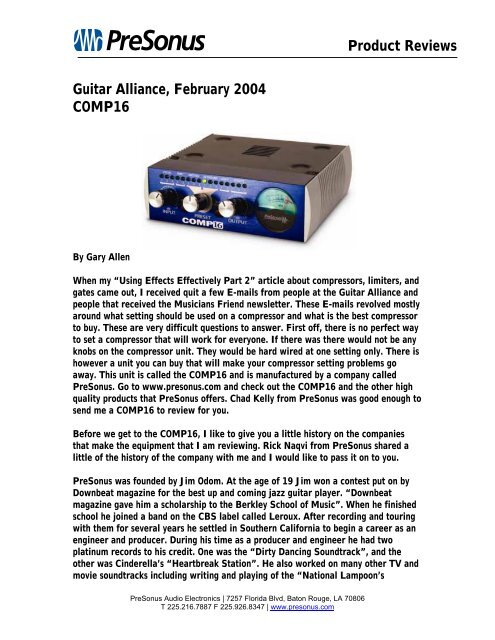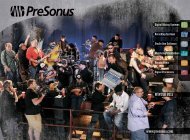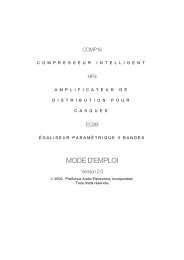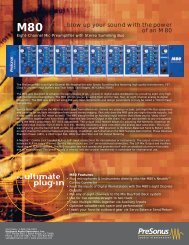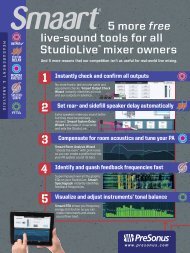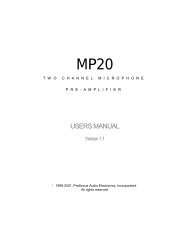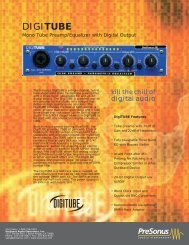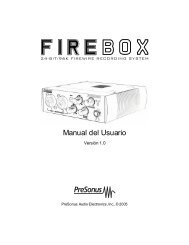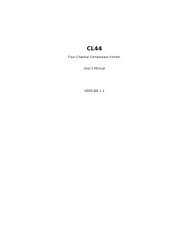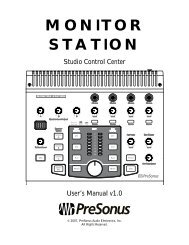Guitar Alliance COMP16 review Feb04 - PreSonus
Guitar Alliance COMP16 review Feb04 - PreSonus
Guitar Alliance COMP16 review Feb04 - PreSonus
You also want an ePaper? Increase the reach of your titles
YUMPU automatically turns print PDFs into web optimized ePapers that Google loves.
Product Reviews<br />
<strong>Guitar</strong> <strong>Alliance</strong>, February 2004<br />
<strong>COMP16</strong><br />
By Gary Allen<br />
When my “Using Effects Effectively Part 2” article about compressors, limiters, and<br />
gates came out, I received quit a few E-mails from people at the <strong>Guitar</strong> <strong>Alliance</strong> and<br />
people that received the Musicians Friend newsletter. These E-mails revolved mostly<br />
around what setting should be used on a compressor and what is the best compressor<br />
to buy. These are very difficult questions to answer. First off, there is no perfect way<br />
to set a compressor that will work for everyone. If there was there would not be any<br />
knobs on the compressor unit. They would be hard wired at one setting only. There is<br />
however a unit you can buy that will make your compressor setting problems go<br />
away. This unit is called the <strong>COMP16</strong> and is manufactured by a company called<br />
<strong>PreSonus</strong>. Go to www.presonus.com and check out the <strong>COMP16</strong> and the other high<br />
quality products that <strong>PreSonus</strong> offers. Chad Kelly from <strong>PreSonus</strong> was good enough to<br />
send me a <strong>COMP16</strong> to <strong>review</strong> for you.<br />
Before we get to the <strong>COMP16</strong>, I like to give you a little history on the companies<br />
that make the equipment that I am <strong>review</strong>ing. Rick Naqvi from <strong>PreSonus</strong> shared a<br />
little of the history of the company with me and I would like to pass it on to you.<br />
<strong>PreSonus</strong> was founded by Jim Odom. At the age of 19 Jim won a contest put on by<br />
Downbeat magazine for the best up and coming jazz guitar player. “Downbeat<br />
magazine gave him a scholarship to the Berkley School of Music”. When he finished<br />
school he joined a band on the CBS label called Leroux. After recording and touring<br />
with them for several years he settled in Southern California to begin a career as an<br />
engineer and producer. During his time as a producer and engineer he had two<br />
platinum records to his credit. One was the “Dirty Dancing Soundtrack”, and the<br />
other was Cinderella’s “Heartbreak Station”. He also worked on many other TV and<br />
movie soundtracks including writing and playing of the “National Lampoon’s<br />
<strong>PreSonus</strong> Audio Electronics | 7257 Florida Blvd, Baton Rouge, LA 70806<br />
T 225.216.7887 F 225.926.8347 | www.presonus.com
Product Reviews<br />
European Vacation” soundtrack. He then went to work in his father’s hydrographic<br />
design company, where he designed under water sonar equipment for the military,<br />
but he always felt his heart being pulled back to music and audio. He did what each<br />
of us should do and followed his heart. He started <strong>PreSonus</strong> in 1995 with a<br />
commitment to creating innovative, and quality equipment for studio and touring<br />
applications. Next year will mark the ten year anniversary of great <strong>PreSonus</strong> audio<br />
products.<br />
The <strong>COMP16</strong><br />
The <strong>COMP16</strong> is a compressor unit that has 16 preset compressions that include (3)<br />
vocal, (2) percussion, (3) fretted, (3) keyboard, (2) limit, and (3) effect compression<br />
settings. The controls on this unit are very easy to operate, and even if you have<br />
never used compression before you will be up and running within minutes of receiving<br />
and opening the package. What <strong>PreSonus</strong> has done with this unit is take sixteen of<br />
the most common compression settings for various instruments and set the Threshold,<br />
Ratio, Attack, and Release for you. These are hard wired settings and they can not be<br />
changed or modified.<br />
Back Panel View<br />
To hook up the Comp 16 you will want to connect the instrument or microphone to<br />
the input on the back of the unit. You will then want to run a cable from the output of<br />
the <strong>COMP16</strong> to the amplifier or mixing board. You have a choice of a balanced or<br />
unbalanced signal depending on whether you use XLR connections or TRS<br />
connections. Once you are connected you are ready to set the controls on the front<br />
panel and play.<br />
Now here is a basic overview of the east to use controls on the <strong>COMP16</strong>.<br />
<strong>PreSonus</strong> Audio Electronics | 7257 Florida Blvd, Baton Rouge, LA 70806<br />
T 225.216.7887 F 225.926.8347 | www.presonus.com
Product Reviews<br />
Font Panel View<br />
The first control knob on the <strong>COMP16</strong> is the “INPUT” control. This controls the<br />
amount of signal that you want to enter the <strong>COMP16</strong> in the beginning stages. It<br />
ranges from -20db to +20db. This input level is always active when you are hooked<br />
up through the unit. After you have set the input level you are going to want to select<br />
the type of compression you want with the selectable preset on the rotary encoder<br />
titled “PRESET”. The last thing you want to do is set the “OUTPUT” level which is<br />
the third and final control knob. This also ranges from -20db to +20db.<br />
The <strong>COMP16</strong> also features a “Bypass” button so you can hear the signal with and<br />
without compression for comparison. Now keep in mind that the input level is always<br />
active. If you have a high input level and a low output level you may have a<br />
considerable amount of gain when you hit the bypass button. Be careful or you may<br />
blow out an eardrum. There is also an “Output Meter” and an “Output to Meter”<br />
button. When the “Output to Meter” button is set at the “in” position the meter will<br />
show you the amount of signal at the output level. This is what the signal will look<br />
like after it is compressed. When the “Output to Meter” button is in the out position<br />
the “Output Meter” will show you the level of gain reduction.<br />
So now that you have an overview of hook-up and controls it is time to play around.<br />
The first thing I did was grab my Takamine acoustic guitar. I went straight through<br />
the <strong>COMP16</strong> to my amplifier. I set the input and output at the 12’oclock position and<br />
chose preset #7 for acoustic guitars. I then put it in gear and started playing with the<br />
input and output levels. I found a spot I liked at “Input 2/3” and “Output 1/3”. I hit<br />
the bypass to get a good feel for the unprocessed sound. I played a few chording<br />
patterns and did some finger picking exercises. After I had a good feel of what it<br />
sounded like without compression I hit the bypass button again to turn the unit on. It<br />
was magic to the ears. The sound was so much tighter and easier to control. When I<br />
went from a strumming part to a finger picking part there was not the drastic volume<br />
drop that so often happens. I did not detect any of the pumping or breathing sound<br />
that is so often associated with compressors. I was hearing an acoustic guitar that<br />
could have come out of any major label studio in the world. I tried some of the other<br />
presets and found that the piano and the soft vocal settings also worked well with the<br />
acoustic also.<br />
<strong>PreSonus</strong> Audio Electronics | 7257 Florida Blvd, Baton Rouge, LA 70806<br />
T 225.216.7887 F 225.926.8347 | www.presonus.com
Product Reviews<br />
Note: Now keep in mind that the settings you like may be different than the ones I<br />
like. While the parameters are hard wired these units still have versatility for the<br />
discriminating ear. Play around with the unit. You may be surprised what you come<br />
up with.<br />
After I was able to put down the acoustic for awhile I plugged into my electric setup.<br />
I use a Digitech 2120 rack mount processor with built in compression. I choose a<br />
nice overdriven bluesy patch and turned off the Digitech’s onboard compression.<br />
(Now I will note for you that this particular patch I selected was one I always liked<br />
but just could not quite get to sound right. It always seemed to have an unnatural<br />
distortion sound that put a muddy feel to the sound of the guitar. I was never able to<br />
get rid of it with the Digitech’s onboard compressor.) I then choose patch #6 on the<br />
<strong>COMP16</strong> and went through the same steps as I did on the acoustic. Again there was<br />
no pumping or breathing sound. Just a smooth overdriven tone that any blues player<br />
would be proud to hear coming from his rig in a live gig. The unnatural distortion<br />
sound was completely gone. I continued to try other patches on the Digitech 2120<br />
from clean to heavy metal and everything in between. The <strong>COMP16</strong> handled<br />
everything that I threw at it with minor adjustment to the input and output controls.<br />
<strong>PreSonus</strong> has done a top notch job in designing a rugged, quality compressor at an<br />
affordable price. The <strong>COMP16</strong> is easy enough for a beginner to use yet has enough<br />
versatility for even a seasoned professional. This unit will serve you well in live<br />
situations, in the studio, and even just at home for jamming. If you are ready to take<br />
your sound to the next level, I highly recommend the <strong>COMP16</strong>. For those of you who<br />
want a compressor with more flexibility go to www.presonus.com and check out the<br />
other fine products offered by <strong>PreSonus</strong>.<br />
If you are just beginning to use a compressor, don’t be afraid to try the other settings<br />
on the <strong>COMP16</strong>. Just because you are playing a piano does not mean that the bass<br />
guitar setting would not provide the sound you want. The names of these settings are<br />
common to the particular instrument they are named for, but that does not mean that<br />
you won’t find them useful on another instrument. Experiment and try the other<br />
settings and maybe you will come up with a sound that will define you as a player.<br />
Half of the fun of using effects is seeing how far you can push the limits of them. In<br />
music the end always justifies the means to finding your perfect sound.<br />
I would like to thank the great staff at <strong>PreSonus</strong> for their great service and friendly<br />
attitude. A special thanks to Chad Kelly and Rick Naqvi at <strong>PreSonus</strong> for sending me a<br />
<strong>COMP16</strong> to try out and providing all the information I requested.<br />
If you have any questions or comments about this <strong>review</strong> you can send me an E-mail<br />
at cgtjs_5@verizon.net and I will get back to you as soon as possible.<br />
<strong>PreSonus</strong> Audio Electronics | 7257 Florida Blvd, Baton Rouge, LA 70806<br />
T 225.216.7887 F 225.926.8347 | www.presonus.com


